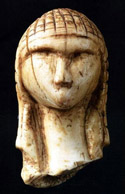Anthropology, Department of

Department of Anthropology: Faculty Publications
Document Type
Article
Date of this Version
2014
Citation
American Antiquity 79(1), 2014, pp. 45-68
Abstract
This paper examines the possible underlying systemic context(s) for spurred flake gravers and eyed bone needles recovered from Paleoindian sites in North America. The idea that spurred flake gravers and eyed bone needles were closely associated is not new. Archaeologists in both Eurasia and North America have also proposed that eyed bone and ivory needles were used for manufacturing tailored skin clothing. It is suggested here that spurred flake gravers and eyed bone needles may, in fact, be the material correlates of critical non-subsistence related work carried out by women to meet the challenges of very severe winters and cold stress of the Younger Dryas Cold Event (YDCE) between 12,900-11,600 cal. B.P. It is argued here that such expediently produced flake implements and curated sewing technology including eyed needles ultimately reflect the significant ecological bottlenecks) posed by the YDCE for Paleoindian populations. Metric attributes of both spurred flake gravers and eyed bone needles, their spatial co-occurrence in archaeological contexts, and their temporal co-occurrence within the YDCE lend empirical support for this causal argument.
Este articulo examina el contexto sistemico subyacente posible (s) de buriles escamas estimulado y agujas de hueso ojos recuperados de sitios paleoindios de America del Norte. La idea de que los buriles escamas estimulado y agujas de hueso ojos estaban estrechamente asociados no es nueva. Los arqueologos tambien han propuesto tanto en Eurasia y America del Norte, que las agujas de hueso y marfil ojos fueron utilizados para la fabrication de prendas de vestir de piel a medida. Se sugiere aqui que buriles escamas estimulado y agujas de hueso ojos pueden, de hecho, el material se correlaciona de trabajo critico no relacionado con la subsistencia que realizan las mujeres para afrontar los retos de inviernos muy severos y el estresfrio del Younger Dryas eventofrio (YDCE) entre 12,900-11,600 cal aap. Aqui se argumenta que tales implementos escamas convenientemente producidos y la tecnologia, incluyendo agujas de coser comisariada ojos reflejan en ultima instancia, el cuello de botella ecoldgica significativa (s) formulada por el YDCE para las poblaciones paleoindios. Atributos metricos de dos buriles estimulado escamas y agujas de hueso, sus ojos espaciales co-ocurrencia en contextos arqueologicos, y su co-ocurrencia de temporales en el YDCE prestan apoyo empirico a este argumento causal.


Comments
Copyright © 2014 by the Society for American Archaeology. Used by permission.